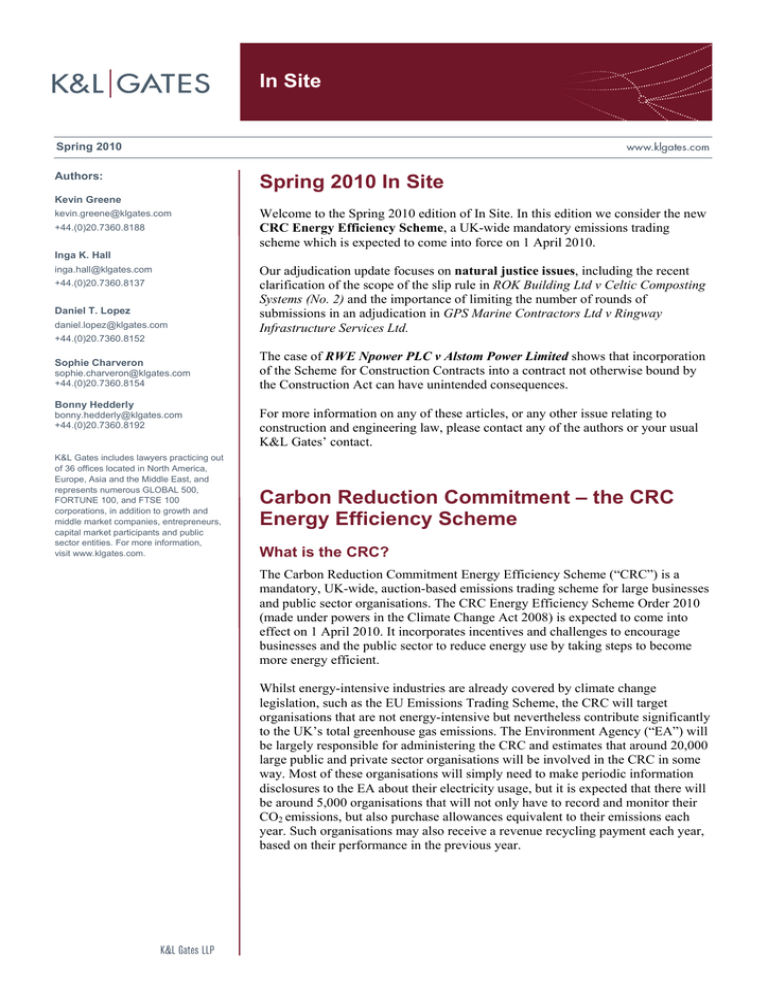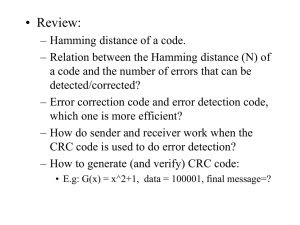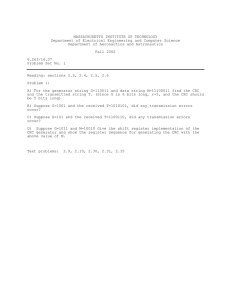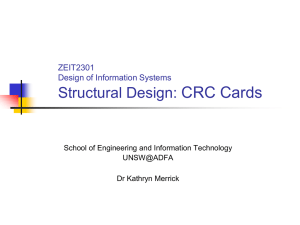
In Site
Spring 2010
Authors:
Spring 2010 In Site
Kevin Greene
kevin.greene@klgates.com
+44.(0)20.7360.8188
Welcome to the Spring 2010 edition of In Site. In this edition we consider the new
CRC Energy Efficiency Scheme, a UK-wide mandatory emissions trading
scheme which is expected to come into force on 1 April 2010.
Inga K. Hall
inga.hall@klgates.com
+44.(0)20.7360.8137
Daniel T. Lopez
daniel.lopez@klgates.com
+44.(0)20.7360.8152
Sophie Charveron
sophie.charveron@klgates.com
+44.(0)20.7360.8154
Bonny Hedderly
bonny.hedderly@klgates.com
+44.(0)20.7360.8192
K&L Gates includes lawyers practicing out
of 36 offices located in North America,
Europe, Asia and the Middle East, and
represents numerous GLOBAL 500,
FORTUNE 100, and FTSE 100
corporations, in addition to growth and
middle market companies, entrepreneurs,
capital market participants and public
sector entities. For more information,
visit www.klgates.com.
Our adjudication update focuses on natural justice issues, including the recent
clarification of the scope of the slip rule in ROK Building Ltd v Celtic Composting
Systems (No. 2) and the importance of limiting the number of rounds of
submissions in an adjudication in GPS Marine Contractors Ltd v Ringway
Infrastructure Services Ltd.
The case of RWE Npower PLC v Alstom Power Limited shows that incorporation
of the Scheme for Construction Contracts into a contract not otherwise bound by
the Construction Act can have unintended consequences.
For more information on any of these articles, or any other issue relating to
construction and engineering law, please contact any of the authors or your usual
K&L Gates’ contact.
Carbon Reduction Commitment – the CRC
Energy Efficiency Scheme
What is the CRC?
The Carbon Reduction Commitment Energy Efficiency Scheme (“CRC”) is a
mandatory, UK-wide, auction-based emissions trading scheme for large businesses
and public sector organisations. The CRC Energy Efficiency Scheme Order 2010
(made under powers in the Climate Change Act 2008) is expected to come into
effect on 1 April 2010. It incorporates incentives and challenges to encourage
businesses and the public sector to reduce energy use by taking steps to become
more energy efficient.
Whilst energy-intensive industries are already covered by climate change
legislation, such as the EU Emissions Trading Scheme, the CRC will target
organisations that are not energy-intensive but nevertheless contribute significantly
to the UK’s total greenhouse gas emissions. The Environment Agency (“EA”) will
be largely responsible for administering the CRC and estimates that around 20,000
large public and private sector organisations will be involved in the CRC in some
way. Most of these organisations will simply need to make periodic information
disclosures to the EA about their electricity usage, but it is expected that there will
be around 5,000 organisations that will not only have to record and monitor their
CO2 emissions, but also purchase allowances equivalent to their emissions each
year. Such organisations may also receive a revenue recycling payment each year,
based on their performance in the previous year.
In Site
purchase allowances to emit CO2 in each
subsequent year (running April to March).
Thresholds and coverage
Qualification for CRC is assessed by reference to
electricity usage. An organisation will qualify for
full CRC participation if (i) at any point during
the relevant qualification period, it had at least
one half-hourly meter (“HHM”) settled on the
half-hourly market and (ii) its annual electricity
supply through all HHMs was at least 6,000
MWh. HHMs are used by electricity suppliers to
calculate electricity bills, and the “half-hourly
market” is the electricity market used by
suppliers and generators to calculate balance or
imbalance in the amount of electricity generated
and supplied.
At current energy prices, the 6,000 MWh
threshold means that the CRC will impact
businesses with electricity bills of approximately
£500,000 per annum. Large offices, hotel chains
and shopping centres are likely to be caught by
this threshold, along with schools, local
authorities and PFI/PPP entities. Detailed
guidance for organisations as to whether the CRC
will apply to them (and, if so, what they must do)
is given in the EA’s “The CRC Energy Efficiency
Scheme User Guide” and which can be accessed
via www.decc.gov.uk.
Key obligations
During the introductory phase, allowances will
be sold at a fixed price of £12 per tonne of CO2.
This phase will not include a cap so CRC
organisations will be allowed to purchase as
many allowances as they need to offset their total
emissions. This phase is intended to allow CRC
organisations to develop their energy efficiency
strategies and to become familiar with the
scheme without being constrained by a cap.
•
From the end of the introductory phase in
2013 however, the number of allowances
will be capped. Allowances can be
purchased by way of an online auction run
by the Government. There will not be any
fixed price from 2013 onwards, rather the
price will be set by the market.
Organisations will need to monitor their
electricity consumption in order to evaluate
the number of allowances they will need to
purchase each year.
•
The number of allowances auctioned each
year will decrease in line with the
Government's target to reduce CO2
emissions, thus providing incentives to
decrease energy usage and increase the
energy efficiency of the CRC organisations’
operation.
•
The CRC Order provides for both criminal
and civil penalties to enforce compliance
with the scheme.
It is likely that the initial threshold energy use
will be lowered over time so that the CRC
captures all CO2 emissions from buildings. More
stringent obligations may also be imposed at a
later stage.
It should also be borne in mind that, whilst
electricity use is the threshold, once a CRC
organisation crosses that threshold all nontransport energy use within the UK (such as
natural gas, fuel and oil) will be caught by the
CRC.
The CRC timeline
The CRC comprises 7 phases governing
emissions targets from now until 2043. The initial
introductory phase will run from 1 April 2010 to
31 March 2013. For practical purposes this means
that initially:
•
from April 2010, organisations covered by
the CRC have to disclose their total
electricity consumption per half hour to the
Government; and
•
from April 2011, those organisations meeting
the threshold outlined above will have to
Who is responsible?
The “customer” of the electricity supplier is the
person or entity who has to comply with the
CRC obligations. It may not, however, always be
obvious who this will be. In the case of parent
and subsidiaries, for example, they will be
treated as one single entity. The parent company
acts as the primary responsible entity under the
CRC, although it may not itself use enough
energy to be captured by the CRC.
Consequently, if the total annual electricity use
of all subsidiaries within a group having halfhourly meters exceeds 6,000 MWh, the group
will be caught by the CRC.
Also of interest is how the CRC will impact on
the landlord and tenant relationship. Landlords
who are CRC participants will be responsible
Spring 2010
2
In Site
under the CRC for energy consumed in relation
to both the buildings they themselves occupy and
their tenanted buildings where they procure the
energy their tenants consume. Where a tenant
itself procures the energy it consumes, it will be
responsible for that energy consumption and the
resulting emissions (where it is large enough to
be a CRC participant in its own right).
Issues will arise in multi-let buildings where the
landlord is responsible for the supply of energy
for the building and, therefore, the landlord's
energy performance will be affected by the
activities of its tenants. The way tenants use and
occupy buildings could have very real financial
implications for the landlord. A property industry
consultation was recently held with a view to
proposing standardised drafting in lease
documents on issues such as how CRC costs
should be apportioned between landlords and
tenants in new leases. The results of that
consultation are awaited.
Conclusion
The CRC is not a building regulation as such but
its aim is ultimately to enhance the efficiency of
existing and future buildings in the UK. The
decrease over time in the number of available
allowances and the increase of the carbon price
are intended to incentivise construction
companies and building owners/developers to
improve the energy efficiency of buildings in the
UK and should encourage landlords and tenants
to work together to improve overall energy
efficiency.
Adjudication update:
natural justice issues
Application of natural justice principles is
obviously important in order to give parties
confidence in the adjudication process. Equally
importantly, however, spurious arguments that
the rules of natural justice have been breached
should not prevent enforcement of adjudicators’
decisions.
In this article we examine two recent Technology
and Construction Court decisions which
considered the appropriate boundaries to
enforcement challenges based on alleged natural
justice breaches.
Scope of the slip rule
The recent case of ROK Building Ltd v Celtic
Composting Systems Ltd (No. 2) [2010] EWHC
66 (TCC) confirmed the limits of an
adjudicator’s power to correct his or her decision
using the “slip rule”. Adjudicators have either an
implied power to correct genuine mistakes or
accidental clerical errors (see Bloor Construction
(UK) Ltd v Bowmer & Kirkland (London) Ltd)
or, as in the ROK case, an express contractual
power. The sub-contract between the parties
contained a provision in clause 28 that the
adjudicator could, within 5 days of delivery of
his decision, “correct his decision so as to
remove any error arising from an accidental
error or omission or to clarify or remove any
ambiguity”.
The contractor (Celtic) sought to resist
enforcement of an adjudicator’s decision in
favour of the sub-contractor (ROK) on the
grounds that the adjudicator had acted unfairly
and contrary to the rules of natural justice in a
number of ways, including a failure to apply the
slip rule.
As well as inviting the adjudicator to apply the
slip rule to correct minor typographical errors
(which he did), Celtic also wanted the
adjudicator to make more substantive changes to
his decision, such as clarifying why he had not
referred to certain incomplete works, and to open
up and revise a payment certificate to reflect his
decision. The adjudicator declined to do so,
stating that those requests “…go beyond the
terms of clause 28 of the procedure and to the
heart of my decision”.
The court agreed with the adjudicator, holding
that what Celtic was asking the adjudicator to do
fell outside the scope of the contractual slip rule
and that the adjudicator “…does not have a right
to correct so wholly to reconsider and re-draft
substantive parts of his decision and in effect to
change his mind on material points of principle”.
In effect, Celtic was alleging that the decision
was wrong, and that is not a matter for the slip
rule. It is a matter for final determination by the
courts or arbitration.
Reservation of rights and rejoinders
In GPS Marine Contractors Ltd v Ringway
Infrastructure Services Ltd [2010] EWHC 283
(TCC) the contractor (GPS) commenced an
adjudication against the employer (Ringway)
under the Scheme for Construction Contracts
(England and Wales) Regulations 1998 (‘the
Scheme”). Ringway wrote to the adjudicator
shortly before it served its response, seeking to
reserve its right to challenge the adjudicator’s
Spring 2010
3
In Site
jurisdiction. As well as a list of specific grounds
of challenge, Ringway reserved its right to raise
“…further jurisdiction issues which we have not
had time or opportunity to investigate. Our
client’s position in this respect is reserved and
the above list should not be understood to be
exhaustive”. Ringway continued to reserve its
rights in the response. After GPS served its reply,
Ringway served a rejoinder two days before the
decision was due. No rejoinder had been
provided for in the adjudicator’s directions and,
in response to Ringway’s request to make further
submissions, the adjudicator expressly said a
rejoinder could not be served. The adjudicator
refused to consider the rejoinder and
subsequently found in favour of GPS.
The court declined to enforce the adjudicator’s
decision at summary judgment stage. Ringway
argued that it had evidence that the parties had
compromised the dispute at an earlier meeting
and the court held that, given that there were
weak, but real, prospects of this argument
succeeding, summary judgment was not
appropriate. What is interesting about this is that
the “compromise argument” was not one of the
specific grounds of challenge Ringway raised at
the beginning of the adjudication but, on the facts
of the case, the general reservation was found to
be sufficient to allow Ringway to take the point
in enforcement proceedings. As the court put it,
“..the question in this case [was]…whether the
words of general reservation were sufficiently
clear to prevent Ringway’s subsequent
participation in the adjudication from amounting
to a waiver or an ad-hoc submission”.
The other main point of interest in this case is
that the court held that the adjudicator had not
breached the rules of natural justice by refusing
to consider the rejoinder. In particular, in the
context of the tight timetable governing most
adjudications, an adjudicator is entitled to, and
needs to, limit the number of rounds of
submissions. The timetable the adjudicator had
set in this case was a fair one, and there was no
“crucial new aspect” to the case which would
justify the rejoinder. The adjudicator had also
made it clear that permission was not given for a
rejoinder, but Ringway served it anyway.
RWE Npower PLC v
Alstom Power Limited
The recent decision in RWE Npower PLC v
Alstom Power Limited [2010] EWHC B40
(TCC) is of particular interest to the drafters of
bespoke contracts which are not automatically
subject to the payment and adjudication
provisions of the Construction Act (the “Act”).
The contract between RWE (as employer) and
Alstom (as contractor) was not a “construction
contract” for the purposes of Part II of the Act as
it fell within the power and water industries
exemptions in section 105. As such the Act did
not apply. Nevertheless, the parties agreed to
incorporate the adjudication provisions of the
Scheme into a deed of variation regarding the
contract.
A dispute arose when certain boiler repair works
overran and Alstom referred its claim for extra
costs to adjudication. Alstom was successful, but
RWE then sought to set off a separate claim for
liquidated damages against the extra costs
awarded by the adjudicator (without issuing a
withholding notice).
This would not be permissible if the contract was
a “construction contract”, as section 111 of the
Act prohibits set-off against a sum due without a
valid withholding notice. RWE argued that
where an adjudication is purely contractual and
no withholding notice provisions are involved,
enforcement of an adjudicator’s decision can be
resisted on the grounds of set-off unless the
contract clearly excludes that right. RWE said it
had an express contractual right of set-off and
that incorporation of the Scheme was not
sufficient to displace that right.
The court disagreed and held that “…by
choosing to incorporate the provisions of the
Scheme rather than their own bespoke provisions
for adjudication, the parties intended to import
into the contract the parliamentary intention
underlying the Scheme… The express choice of
the Scheme, rather than of any other set of
adjudication provisions, brings with it the
purpose underlying it and the interpretation it
has received in its statutory context”. The
wording of the set-off clause was not, on the
facts of this case, sufficient to displace the
intention behind the Scheme, namely that
“...adjudication decisions…be honoured without
resort to the set-off of cross-claims”. A
deduction by way of set-off from the sum
Spring 2010
4
In Site
ordered by the adjudicator to be paid would not
be due compliance with the decision. The
decision may well have been different if the
wording of the set-off clause had been more
explicit and it is also worth noting that if the
parties had written out the Scheme terms as
bespoke contract terms and not actually referred
to “the Scheme” itself, these unintended
consequences, i.e incorporation of the payment
principles of the Act, might have been avoided.
Anchorage Austin Beijing Berlin Boston Charlotte Chicago Dallas Dubai Fort Worth Frankfurt Harrisburg Hong Kong London
Los Angeles Miami Moscow Newark New York Orange County Palo Alto Paris Pittsburgh Portland Raleigh Research Triangle Park
San Diego San Francisco Seattle Shanghai Singapore Spokane/Coeur d’Alene Taipei Tokyo Warsaw Washington, D.C.
K&L Gates includes lawyers practicing out of 36 offices located in North America, Europe, Asia and the Middle East, and represents numerous
GLOBAL 500, FORTUNE 100, and FTSE 100 corporations, in addition to growth and middle market companies, entrepreneurs, capital market
participants and public sector entities. For more information, visit www.klgates.com.
K&L Gates is comprised of multiple affiliated entities: a limited liability partnership with the full name K&L Gates LLP qualified in Delaware and
maintaining offices throughout the United States, in Berlin and Frankfurt, Germany, in Beijing (K&L Gates LLP Beijing Representative Office),
in Dubai, U.A.E., in Shanghai (K&L Gates LLP Shanghai Representative Office), in Tokyo, and in Singapore; a limited liability partnership (also
named K&L Gates LLP) incorporated in England and maintaining offices in London and Paris; a Taiwan general partnership (K&L Gates)
maintaining an office in Taipei; a Hong Kong general partnership (K&L Gates, Solicitors) maintaining an office in Hong Kong; a Polish limited
partnership (K&L Gates Jamka sp. k.) maintaining an office in Warsaw; and a Delaware limited liability company (K&L Gates Holdings, LLC)
maintaining an office in Moscow. K&L Gates maintains appropriate registrations in the jurisdictions in which its offices are located. A list of the
partners or members in each entity is available for inspection at any K&L Gates office.
This publication is for informational purposes and does not contain or convey legal advice. The information herein should not be used or relied
upon in regard to any particular facts or circumstances without first consulting a lawyer.
©2010 K&L Gates LLP. All Rights Reserved.
Spring 2010
5





